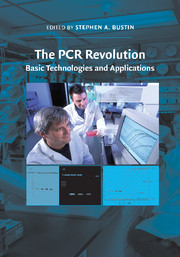Book contents
- Frontmatter
- Contents
- Contributors
- Foreword by Russell Higuchi
- Preface
- I BASIC TECHNOLOGIES
- II APPLICATIONS
- 10 Polymerase chain reaction–based methods for the detection of solid tumor cancer cells for clinical diagnostic and prognostic assays
- 11 Polymerase chain reaction and infectious diseases
- 12 Polymerase chain reaction and respiratory viruses
- 13 Polymerase chain reaction and severe acute respiratory syndrome
- 14 The MMR vaccine, measles virus, and autism – A cautionary tale
- 15 Noninvasive prenatal diagnosis using cell-free fetal nucleic acids in maternal plasma
- 16 Polymerase chain reaction–based analyses of nucleic acids from archival material
- 17 Microarrays and quantitative real-time reverse transcriptase–polymerase chain reaction
- 18 Polymerase chain reaction in the detection of genetic variation
- 19 Polymerase chain reaction: A blessing and a curse for ancient deoxyribonucleic acid research
- Index
- Plate section
- References
16 - Polymerase chain reaction–based analyses of nucleic acids from archival material
Published online by Cambridge University Press: 25 January 2011
- Frontmatter
- Contents
- Contributors
- Foreword by Russell Higuchi
- Preface
- I BASIC TECHNOLOGIES
- II APPLICATIONS
- 10 Polymerase chain reaction–based methods for the detection of solid tumor cancer cells for clinical diagnostic and prognostic assays
- 11 Polymerase chain reaction and infectious diseases
- 12 Polymerase chain reaction and respiratory viruses
- 13 Polymerase chain reaction and severe acute respiratory syndrome
- 14 The MMR vaccine, measles virus, and autism – A cautionary tale
- 15 Noninvasive prenatal diagnosis using cell-free fetal nucleic acids in maternal plasma
- 16 Polymerase chain reaction–based analyses of nucleic acids from archival material
- 17 Microarrays and quantitative real-time reverse transcriptase–polymerase chain reaction
- 18 Polymerase chain reaction in the detection of genetic variation
- 19 Polymerase chain reaction: A blessing and a curse for ancient deoxyribonucleic acid research
- Index
- Plate section
- References
Summary
The qualitative and quantitative analysis of genetic material obtained from so-called “archival” tissue specimens (see next section for a definition of “archival”) is nowadays a routine operation in modern molecular laboratories thanks to improvements in the extraction methods of nucleic acids and subsequent amplification technology.
Today it is not only possible to analyze localized alterations like point mutations or the expression level of single genes in archival samples, but also to analyze large stretches of genomic material (up to several million base pairs of deoxyribonucleic acid [DNA] sequence) and to assess the expression level of thousands of genes in parallel. For nearly all applications, a polymerase chain reaction (PCR)-based amplification step of the extracted nucleic acid is necessary, and many investigations of this kind are virtually impossible without a powerful amplification technology like PCR. Therefore, “analysis of genetic material from archival specimens” is nearly synonymous with the title of this chapter.
First the word “archival” is explained a bit more in detail and the advantages of archival specimens in general are summarized. Then, several areas of basic and clinical research as well as routine diagnostics are described for which the ability to analyze genetic material extracted from archival specimens represents a major technological advancement, and that is aptly titled a “revolution.”
WHAT DOES “ARCHIVAL” MEAN?
The term “archival” in the title of this chapter has a specific meaning in the context of processing and storing tissue samples from human beings or animals for the purpose of histopathological examination, but it is also used in both a somewhat broader sense and a much broader sense.
- Type
- Chapter
- Information
- The PCR RevolutionBasic Technologies and Applications, pp. 254 - 261Publisher: Cambridge University PressPrint publication year: 2009



